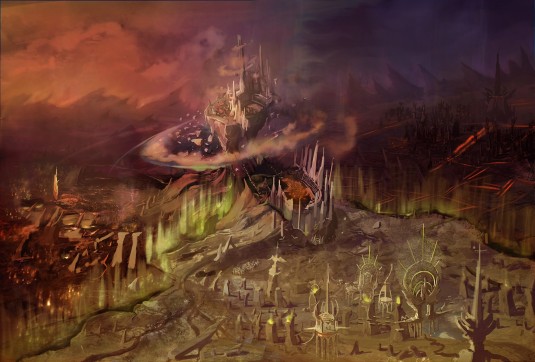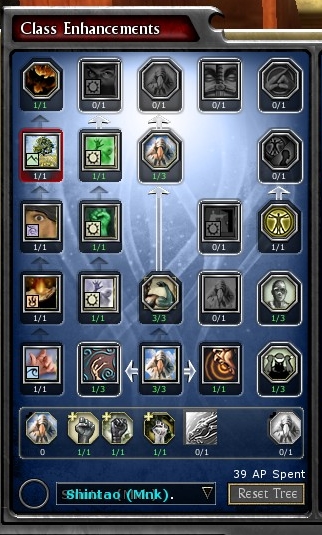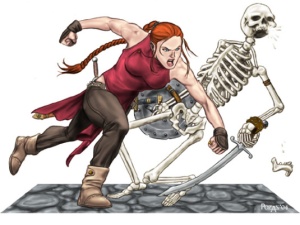
The eternal battlefield. Are you too scared to take on the devils on their home turf? Leave your Epic excuses behind, stop being a baby and go fight for REAL.
I don’t know of many guildmates that bother to hang around in the Devil Battlefield much nowadays, especially with the Epic content in the Forgotten Realms.
But there is still much to be gained there between levels 18 and 24, especially for a Monk.
Before the Menace of the Underdark expansion, the Tower of Despair raid was a popular run, even for PuGs.
To run this raid required a character to complete the four flagging quests: “Genesis Point,” “A New Invasion,” “Bastion of Power,” and “Sins of Attrition.” You also needed to make sufficient runs through the two standalone quests, “Wrath of the Flame” and “Weapons Shipment,” to farm for four ingredients to make the special Boots of Anchoring, needed by melee classes in particular to avoid getting banished back to Eberron by one of the bosses during the raid itself.
Further, in comparison to other Level 19 quests, Shavarath enemies are demons and devils. They’re often filled with immunities and require at least Good-aligned weapons, never approach you short-manned and have bags of hit points to wear you down.
No wonder fewer people run this series.
But that doesn’t mean you shouldn’t, especially with Epic questing.
Reason 1: Yugoloth Potions
Today, the most important thing your characters can gain from the Shavarath quests are Yugoloth Favor Potions. As the name suggests, you gain access to a special vendor when you have sufficient Yugoloth favor. This means you’ll need to run, at minimum, three of the four quests on Elite.
I found that you can leave “A New Invasion” on Hard and complete the others on Elite for sufficient favor, as the end-fight with “Invasion” is a claustrophobic nightmare of trapped floors and a very angry Pit Fiend, chasing you and chaining you to the floor to disembowel you on Elite difficulty.
So what’s special about the “Yugo potions?” They raise your ability scores, a +2 bonus that stacks with anything, including the DDO Store elixirs.
The downside to Yugo potions is that they also have side effects. For Monks, the four potions they’d favor might be the Essence of Betrayal (+2 DEX), Essence of Desire (+2 CON), Essence of Despair (+2 WIS) and Essence of Fury (+2 STR).
In addition to the ability score change, the Essence of Betrayal will also increase your Sneak Attack bonus but decrease your general attack bonus. The Essence of Desire adds a stacking +20 HP but slows your melee attacks by 5%. The Essence of Despair adds +4 to your Natural Armor bonus but saps -4 from your Reflex saves, while the Essence of Fury adds +8 to your Will saves against Fear while sapping your general Will saves to everything else by -4.
In Epic play, getting your WIS modifier and your STR and CON as high as you can is critical. The Yugo potions, in combination with the DDO Store potions, give you +4 to any ability score. The Yugo potions last 15 minutes.
Reason 2: Incredible Potential rings and their companion items
Any ring from the end-rewards of the Tower of Despair raid can be unlocked to show its “incredible potential.” For unarmed Monks, this means you can unlock a ring’s ability to add Holy Burst or other elemental burst effects to your attacks. Since a Shintao Monk can already train to bypass Silver DR, you become a natural Harry Beater with a Holy Burst ring. Again, this works for unarmed Monks only. However, other effects of the rings, from spell power boosts to elemental absorption to Insightful stat bonuses, can also be available to any class.
It takes a while to make this work. First, get a ring from the raid. The drop rate isn’t high. Some in the party may be looking for the specific set ring for their class and choose instead to let others in the party to roll for their lucky allotment. All rings are Bound to Character on Acquire so you can’t trade them outside of the raid chest.
The rings are also Exclusive. If you happen to gain a second Monk set ring of the same name, you can’t keep it if you already have one in your inventory. I’d be biased and have any Monks roll for it first in party.
Each time you run the raid, you’ll also get a Shavarath War Trophy. You need 9 of these special ingredients, plus a properly imbued Shard of Great Power to unlock the ring.
Getting the class set item (for Monks, the Shintao Cord, Nyoko’s Necklace or Oremi’s Necklace) that matches the ring is a bonus but not required. You’ll find these items drop in the chests through all the flagging quests.
Teacher Syncletica has been the luckiest, owning an unlocked Kyosho’s Ring and its Shintao Cord. Wearing both gives her unarmed Good or Evil DR bypassing in addition to the Holy Burst on her ring.
Reason 3: Bragging Rights
The Devil Battlefield is, well, a battlefield. Nothing comes easy from a place that’s acquainted to eternal war. The mere victories of one adventurer mean nothing to those in Shavarath, unless you happen to come to their turf and kick their ass. A lot.
Which is exactly what GamerGeoff and his Gamer Girl recently did. Every quest, on Elite. They brought in level 20 and 21 characters. Hardly “Epic” characters that used strategy and the right firepower to complete. I know of many people that are horrified, and I mean horrified, to complete the Weapons Shipment at any difficulty, much less Elite. For characters like Szyncletica, it’s generally a turkey shoot. Lynncletica sees it as a good workout.
And I took Kiricletica through the whole Battlefield myself weeks before, dead-solo with no hirelings (except in one required quest, Genesis Point) and beat everything (that could find me while stealthy) on Elite difficulty to get her sufficient Yugo privileges.
Sure, few of us enjoy the devils. They’re tough. They’re meant to be.
But defeating the tough enemies, not getting an easy out…isn’t that what we play to do?
Go kick lots of Shavarath ass, or go home.
Update: Teacher Mernom also noted in the comments that there are alchemical ability score potions you can trade, using collectibles, from several vendors in House Deneith, that can also raise your ability scores, albeit very briefly (2 minutes). The Potion of Reason and the Potion of Health are two examples. You don’t need to go to Shavarath to get them, necessarily, unless the collectable you need happens to spawn there. I’ve played the game for over 4 years and never knew these existed. Thanks!






Recent Comments